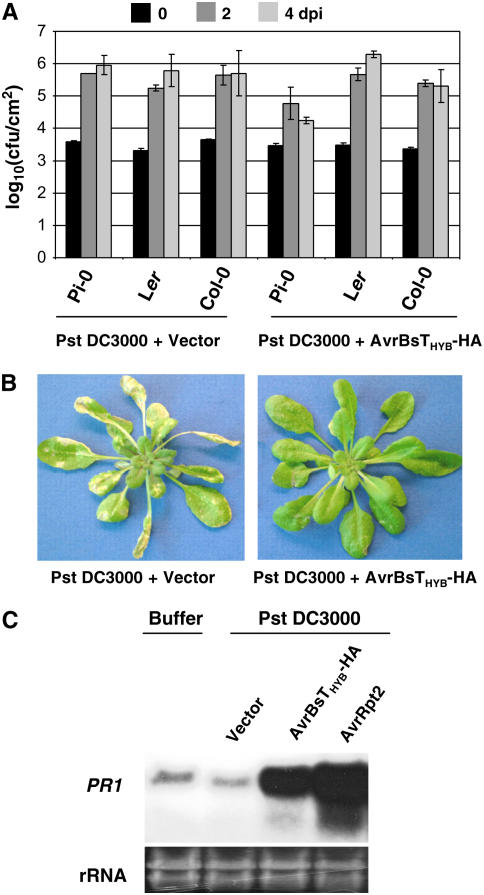Figure 3.
Pi-0 Plants Recognize AvrBsT and Restrict Pst DC3000 Growth.
(A) Growth of Pst DC3000 strains in Pi-0, Ler, and Col-0. Leaves were hand-inoculated with a 105 cfu/mL suspension of bacteria carrying pVSP61 or pVSP61(avrRpt21-100-avrBsT11-350-HA), designated as Pst DC3000 + Vector and Pst DC3000 + AvrRpt2-AvrBsT11-350-HA, respectively. Bacteria present in leaves were monitored at 0 d (black bars), 2 d (dark gray bars), and 4 d (light gray bars) after inoculation (dpi). Data points represent the mean log10 (cfu/cm) ± sample sd for four replicates.
(B) Pi-0 plants are susceptible to Pst DC3000 and resistant to Pst DC3000 expressing AvrRpt2-AvrBsT11-350-HA. Pi-0 plants were dipped in a 2 × 108 cfu/mL suspension of Pst DC3000 carrying pVSP61 (left panel) or pVSP61(avrRpt21-100-avrBsT11-350-HA) (right panel). Symptoms were photographed at 5 d after inoculation.
(C) RNA gel blot showing PR1 mRNA expression in Pst DC3000–infected Pi-0 plants. Leaves were hand-inoculated with 1 mM MgCl2 (buffer) or a 5 × 107 cfu/mL suspension of Pst DC3000 carrying pVSP61, pVSP61(avrRpt21-100-avrBsT11-350-HA), or pVSP61(avrRpt2), designated as Vector, AvrRpt2-AvrBsT11-350-HA, and AvrRpt2, respectively. Total RNA was isolated at 8 h after inoculation. The blot was hybridized to a probe specific for the PR1 gene. Twenty micrograms of total RNA was loaded in each lane. Ethidium bromide–stained rRNA present in each lane served as a loading control.

